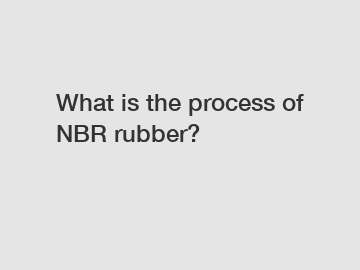What is the process of NBR rubber?
The process of NBR rubber involves a series of steps to produce this type of synthetic rubber. NBR, which stands for nitrile butadiene rubber, is a versatile material that exhibits excellent resistance to oil, fuel, and chemicals, making it ideal for various industrial applications.
The production of NBR rubber starts with the polymerization process. In this step, butadiene and acrylonitrile monomers are mixed together in the presence of a catalyst, typically an organic peroxide. The reaction between the monomers forms a copolymer, which is the base material for NBR rubber.
After the polymerization, the copolymer is then subjected to a curing process. This process involves the addition of sulfur or other curing agents, which helps to crosslink the polymer chains and improve the material's physical properties. The curing process is typically carried out at elevated temperatures to facilitate the crosslinking reaction.

Once the curing is complete, the NBR rubber is then processed further to achieve the desired shape and size. This can be done through various methods such as extrusion, molding, or calendaring. Extrusion involves forcing the NBR rubber through a die to create a continuous shape, such as tubes or gaskets. Molding, on the other hand, uses a mold to shape the rubber into specific forms, including seals, O-rings, or grommets. Calendaring is a process that uses rollers to flatten the rubber into sheets or films.
The use of NBR rubber has significant implications in various industries. Its excellent resistance to oil and chemicals makes it suitable for manufacturing gaskets, seals, and hoses used in automotive, aerospace, and oil and gas industries. NBR rubber's ability to withstand high temperatures and its mechanical properties also make it a preferred material for making conveyor belts, rollers, and other industrial components. Additionally, NBR rubber's resistance to abrasion and wear extends the lifespan of products, reducing the need for frequent replacements and minimizing maintenance costs.
In conclusion, the process of NBR rubber involves polymerization, curing, and shaping. Understanding the steps and factors involved in its production provides insights into the characteristics and applications of this versatile material. NBR rubber's resistance to oil, fuel, chemicals, and its ability to withstand high temperatures make it a valuable material in various industries. Its durability and longevity have a positive impact on product performance and maintenance costs.
For more information, please visit buy colored rubber o rings, shock absorber rubber damper, wholesale round rubber gasket.

Comments